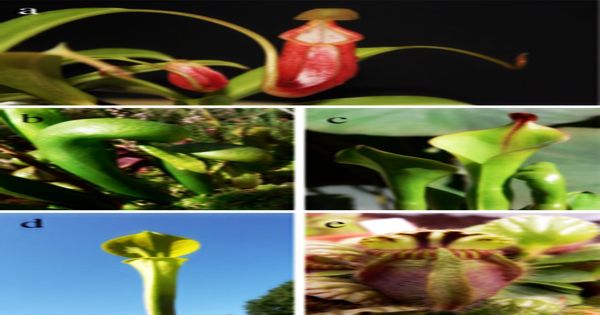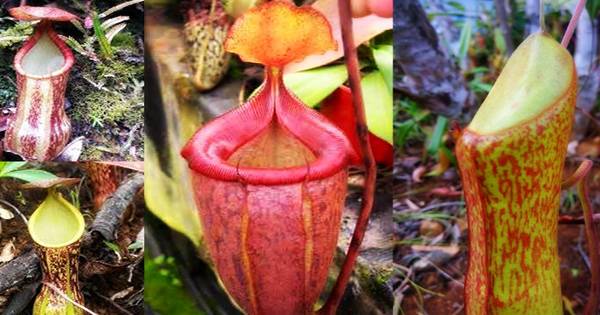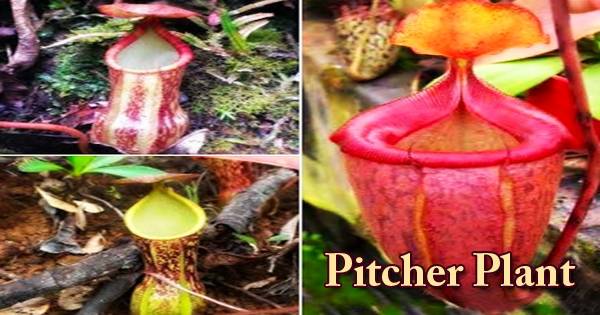Pitcher plant, any pitcher-shaped leaves of carnivorous plants that form a passive pitfall trap. Specialized leaves form the traps of what are known to be “true” pitcher plants. With nectar, the plants attract and drown their prey. Pitcher plants from the Old World are members of the Nepenthaceae (order Caryophyllales) family, whereas those from the New World belong to the Sarraceniaceae family (order Ericales). The sole species of the Cephalotaceae (order Oxalidales) family is the Western Australian pitcher plant (Cephalotus follicularis). The plant’s hollow pitcher was originally intended by naturalists to be nothing more than a hiding place for the insects they saw there. In 1815, a botanist more closely noticed and noted that the insects attracted by the nectar of the plant died inside.
The word “pitcher plant” usually refers to members of the families Nepenthaceae and Sarraceniaceae, but the monotypic Cephalotaceae and some members of the Bromeliaceae use similar pitfall traps. The most species-rich families of pitcher plants are the Nepenthaceae and Sarraceniaceae families. In a wide variety of environments with poor soil conditions, from pine barrens to sandy coastal swamps, pitcher plants are actually found and depend on carnivory to obtain nutrients such as nitrogen and phosphorus.

(Different Types of Pitcher Plant)
In honor of Dr. Michel Sarrazin, a French surgeon and naturalist who immigrated in the 17th century to “New France” in North America, the genus name is “Sarracenia”. He sent specimens of many native plants to be studied by the Academy of Sciences in France, including pitcher plants. The ‘Sarraceniaceae’ family consists of three pitcher plant genera and is distributed in North America and in South America in the western portion of the Guiana Highlands. Bogs, swamps, wet or sandy meadows, and savannas where the soils are water-saturated, acidic, and deficient in nutrients are usually populated by members of this family. This family’s carnivorous traps usually mimic trumpets, pitchers, or urns and catch insects primarily.
The Cephalotaceae is a monotypical family of Cephalotus follicularis, with but one genus and species. This species has a small pitcher similar in shape to those of Nepenthes (2–5 cm). It occurs in southwestern Australia in only one area. Flowers bloom on long stems in early spring, to prevent trapping possible pollinators. In the fall, seed pods turn brown and split, scattering seeds. A trail of nectar-secreting glands running downward along the lip to the interior of the pitcher draws insects and other prey to the mouth of the pitcher. The pitcher’s throat, just below the lip, is very smooth and sends the animal to the bottom of the pitcher where it drowns, tumbling down into the liquid pool. Then enzymes secreted inside the leaf digest the body.
A few bromeliads (Bromeliaceae) species, such as Brocchinia reducta and Catopsis berteroniana, are recognized or suspected of being carnivorous. The floral symbol of the province of Newfoundland and Labrador, Canada, is the purple pitcher plant, Sarracenia purpurea. The purple or common, pitcher plant (S. purpurea) has strongly veined, green to reddish, flaring, juglike leaves bearing downward-pointing bristles to prevent the escape of prey, including salamanders. Its flowers are red-violet. When moistened by condensation or nectar, the pitcher’s rim (peristome) is slippery, allowing insects to fall into the trap. In order to ensure that insects do not climb out, pitcher plants can also produce waxy scales, protruding aldehyde crystals, cuticular folds, inward and downward-pointing (retrorse) hairs, or guard-cell-originating lunate cells on the inside of the pitcher.

(Colorful Pitcher Plants)
From the Texas wetlands and the swamps of Florida to the marshes of southern Canada, between 8 and 15 species of American pitcher plants can be found. However, most species have very limited ranges since they thrive only in areas such as swamps, lake margins, riverbanks, bogs, fens, marshes, and springs that are permanently damp. Phytotelmata are called the tiny bodies of liquid trapped within the pitcher traps. They drown an insect whose body dissolves gradually. This can occur through bacterial activity (through rainfall, the bacteria are washed into the pitcher), or through enzymes secreted by the plant itself. There are thin, fat red-veined leaves in the parrot pitcher plant (S. psittacina) that are topped by beaklike lids and bear dark red flowers. Dull red, violet-scented flowers are produced by the sweet pitcher plant (S. rubra). The crimson pitcher plant (S. leucophylla) has white trumpet-shaped pitchers and scarlet flowers with ruffled upright hoods.
In addition, some pitcher plants produce mutualistic larvae of insects that feed on prey trapped and whose excreta the plant absorbs. The prey elements are converted into a solution of amino acids, peptides, phosphates, ammonium, and urea from which the plant obtains its mineral nutrients, regardless of the digestion process (particularly nitrogen and phosphorus). There are bright yellow flowers on the yellow pitcher plant (S. flava) and a long green, trumpet-shaped leaf whose lid is held upright. One species is critically endangered, the green pitcher plant (S. oreophila), found in small areas in Alabama, Georgia, North Carolina, and Tennessee. They all thrive in areas where the soil is too low in minerals and/or too acidic for most plants to live, just like all carnivorous plants. Pitcher plants complement the components of their insect prey with usable nutrients and minerals (which plants usually acquire from their roots).
The insect’s body is steadily dissolved by a reservoir of digestive acids and enzymes at the bottom of the pitcher. The pitcher plant consumes from its prey essential nitrate nutrients and phosphates, which can be ants, flies, wasps, bees, beetles, slugs, and snails. The only member in its genus is the cobra plant (Darlingtonia californica) and is native to swamps in the northern California and southern Oregon mountain regions. Its pitcher-like hooded leaves resemble striking cobras and bear purple-red appendages which look like the forked tongue of a snake or a collection of fangs. The cobra plant does not tend to develop digestive enzymes, unlike other pitcher plants, and instead relies on bacteria to break down its prey.
Tree shrews (Tupaia montana), which feed on nectar that the plant produces but also defecate into the pitcher, supplying nitrates and other nutrients, are attracted by mature plants of Nepenthes lowii. There is a symbiotic relationship between the plant and the tree shrew. The “pitchers” of this plant are actually specialized leaves which develop in a funnel shape. The pitcher’s lip releases secretions which attract its tiny prey. Over the top of the pitcher, a “hood” stretches and stops rainwater from filling it up and diluting the deadly brew inside. Known as sun pitchers or marsh pitcher plants, the genus Heliamphora consists of some 23 species native to western Brazil, Guyana, and Venezuela’s Rainforest Mountains. On ridge crests and swampy depressions, these species form cushions and bear stout pitchers that can exceed 50 cm (20 inches) in height.
The shape of the rim of the pitcher and the nectar location ensure that as it drinks, the animal’s hindquarters are over the rim. Herbaceous perennials are pitcher plants; they blossom in spring, then wither and go dormant in winter. In clumps, they grow and can spread to several feet in diameter. Pitchers can be 6 inches to more than 36 inches tall, depending on the species. The Cephalotaceae family has only one genus with a single species, the pitcher plant of Western Australia (Cephalotus follicularis). In addition to its pitfall traps, it bears “traditional” leaves, unlike most other pitcher plants. Some families of pitcher plants (such as Nepenthaceae) are placed within clades consisting mainly of flypaper traps, suggesting that some pitchers may have developed from mucilage loss from the common ancestors of today’s flypaper traps.
Information Sources:
















